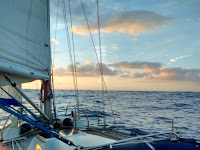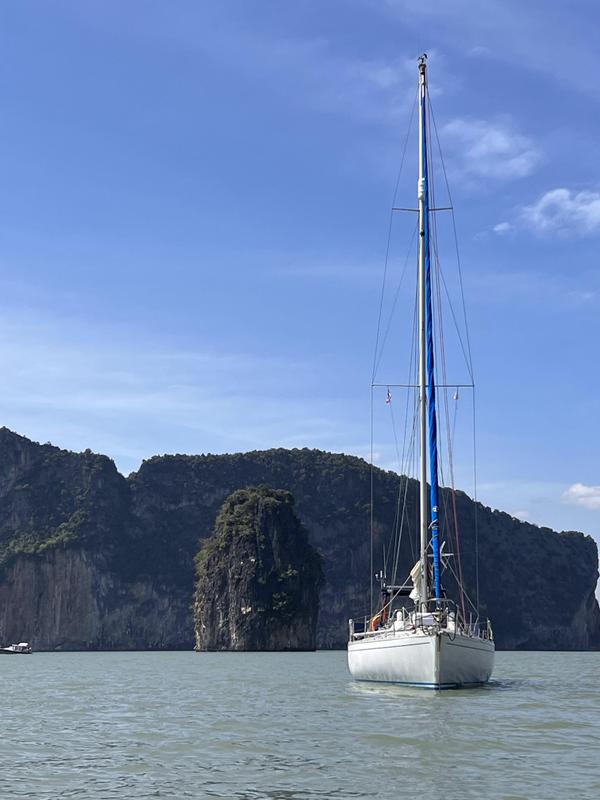 |
| In she goes. Pasito Blanco |
The preparations for
departure started in earnest in mid December with Christoph, Yorgos
and I catching a 0630 flight, from Gatwick to Gran Canaria, and
thence a return to the marina at Pasito Blanco. Our plan was to spend
ten days onboard Kurukulla, antifouling her and getting her ready for
launch; then, once she was safely in the water, this would be
followed by a relaxing Christmas and New Year in a small resort hotel
in Maspalomas (10 minutes by car from Pasito Blanco). Thereafter we
would despatch Yorgos back to Greece on the 2nd of January
(he was not keen to make the passage across the Atlantic) and collect
our final crew member, Malvena, from the airport on the 3rd.
All of this would be followed by victualling with all the fresh
produce we required on the day before departure. All we needed now
was to determine the date!
 |
| Rustica restaurant, last night |
The forecast for our intended day, 6th
of January, was not good; strong winds from a not particularly
helpful direction; but the 7th looked OK. As the 6th
is a public holiday in Spain, when nothing opens, victualling had to
be done on the 5th and thus it was that the early morning
of the 7th saw us doing a final top up at the fuelling
jetty followed by motoring out of Pasito Blanco for the final time.
07/0900Z and we were off! The only item that got missed was
publishing a pre departure blog!
Our first two hours
were dogged by light winds as we moved out of the wind shadow of Gran
 |
| Fruit and veg stowage! |
Canaria but as soon as we were clear we settled onto a broad reach,
doing 7 kts plus and heading south west towards the Cape Verde
Islands. Our plan was to head for 20N/20W until the winds started to
veer and then turn westwards as the winds would permit.
 |
| Atlantic sunset |
The old
sailing adage “Sail south until the butter melts and turn right”
still applies today!
The first night at sea
was lively, not only because of the remaining seas from the earlier
strong winds but we had 20+ knots over the deck and were doing 8-9
kts. This lasted for most of the first 48 hours, a good start! From
there on we had following winds throughout, reducing as we moved
further west until we were three days out of Antigua when the winds
started to increase again.
 |
| Leaving Pasito Blanco |
Our worst two days were two consecutive
days almost becalmed in the middle of the Atlantic, but at least that
gave us a chance for a swim and good wash!
 |
| Part way across |
Before departing we had
also procured some fishing gear, nothing fancy just a reel and lures;
and so on the eighth day of the crossing, after our fresh meat
supplies had been exhausted, we streamed it astern, more in hope than
expectation.
 |
| The skipper in preferred dress style |
Two hours later we were hauling in our first catch, a
Blue Fin Tuna we think, which made for a rather special meal the
following evening.
 |
| Surgeon at work. |
Inspired with our success we streamed it again for
several days later in the crossing..... we caught nothing else, only
seaweed!
As I have said above
the winds were all from astern (with the exception of one very short
period of fickle headwinds in the lull) and almost too much so.
Running directly down wind in the following seas of the Trade Wind
belt is not particularly comfortable and hence we tended to tack
downwind, keeping the wind 15 deg on the quarter for comfort and to
avoid excessive flogging of the mainsail when the winds were light.
Notwithstanding this the cacophony of sounds from the mainsail and
mast kept us awake on several nights!
 |
| A happy crew! |
I can understand why some adopt
twin foresails and dispense with the mainsail for such conditions!
The other variable was rain. Almost not a day passed without us
encountering at least one rain cloud and the associated stronger
winds in its vicinity. Sometimes no more than drizzle but just
occasionally a real downpour.
 |
| The gathering rain clouds |
My one concern for the
crossing had been water supplies. We started with full tanks (240
ltrs) and 40 ltrs of reserve in bottles. To my amazement we used only
130 ltrs for the whole crossing.
In fact, once it became evident that
water was not in short supply, it became a challenge to see how
little we could use! Cleaning one's teeth in salt water really is not
unpleasant!
 |
| Chasing the end of the rainbow |
At 1500 on Saturday
27th of Jan we sighted Antigua for the first time, in the
haze, at a range of 9 miles. It was to be another three hours before
we dropped anchor in Five Islands Bay and settled down for a well
earned rest! The crossing had taken exactly 20.5 days with an average
speed of 5.7 kts.
 |
| Mid Ocean dip |
The forecast for the next two days was not great
and so we were in no hurry to move into Jolly Harbour Marina. We
spent 36 hours at anchor in the bay relaxing, swimming and generally
recovering from the crossing. By 1000 Monday the 29th we
were ready for entry. We motored southwards through the gap between
the Five Islands and the mainland and entered the buoyed channel
leading to the marina. Within 15 minutes we were alongside the
Immigration/Customs/Harbour Master's offices and the process of
entering Antigua commenced.
 |
| Entering Jolly Harbour, Antigua |
The officials were jolly, courteous and
welcoming whilst the system was efficient and all executed in one
place. Both Turkey and Greece could learn a lot from the authorities
in Antigua on how to manage visiting yachts!
 |
| Five Islands Bay, where we anchored after arrival. |
From here we radioed in
to Jolly Harbour and confirmed our request for a berth at which point
we were told to wait where we were for 20 mins when they would
contact us again. 20 minutes later William arrived in a RIB to pilot
us into our berth and assist with the berthing manoeuvres; very
efficient he was too. That was it we were here and ready to relax.
 |
| Berthed in Jolly Harbour |
Lunch in one of the waterfront restaurants was the next order of the
day................
More once we have
departed ….....

No comments:
Post a Comment